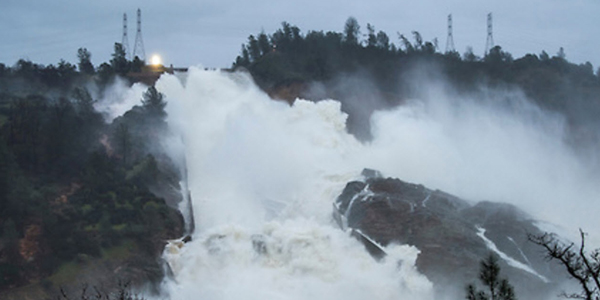Responding to the 2017 Oroville Dam incident, FERC on Thursday proposed tougher safety standards for commission-regulated hydropower projects, including a two-tier safety inspection process (RM20-9).
The Notice of Proposed Rulemaking would change part 12 of FERC’s regulations to codify existing guidance requiring certain licensees to develop dam safety and public safety programs and update regulations regarding incident reporting.
The two-tier inspection structure would include a comprehensive assessment and a periodic inspection.
As under current rules, an inspection by an independent consultant would continue to be required every five years, but the scope would alternate between a “comprehensive” assessment and a “periodic” inspection. These inspections will be in addition to FERC staff’s safety inspections.
The alternating two-tier structure is similar to those used by the Bureau of Reclamation and the U.S. Army Corps of Engineers. “The comprehensive assessment would require a more in-depth review than the current part 12 inspection, would formally incorporate the existing potential failure modes analysis process and would require a semiquantitative risk analysis,” FERC said. “The periodic inspection would have a narrower scope than the current part 12 inspection and focus primarily on the performance of project works between comprehensive assessments.”
FERC also would change how it evaluates the qualifications of the consultants to ensure those conducting inspections have sufficient expertise for site-specific conditions under what is known as the Part 12D Program.
The change follows a recommendation by the Federal Emergency Management Administration that “the inspection team should be chosen on a site-specific basis considering the nature and type of dam … [and] should comprise individuals having appropriate specialized knowledge in structural, mechanical, electrical, hydraulic and embankment design; geology; concrete materials; and construction procedures.”
FERC said the change “reflects the reality that, for many of the hydropower projects under the commission’s jurisdiction, a single independent consultant will not possess the appropriate degree and diversity of technical proficiency necessary to evaluate all aspects of the project.”
The current requirement that an independent consultant be a licensed professional engineer with a minimum of 10 years’ experience in “dam design and construction and in the investigation of the safety of existing dams” would remain. “However, as proposed, this requirement would apply only to the designated independent consultants and not to other supporting members of the independent consultant team,” FERC said.
Oroville Dam Failure
The commission said the proposed changes are the product of recommendations that resulted from an analysis of the February 2017 incident in which the Oroville Dam in California saw major damage to its primary spillway and the first activation of its auxiliary spillway. About 180,000 people were forced to evacuate the surrounding area.
An independent forensics team concluded there was no single cause of the failure of the dam’s spillway. “The incident was caused by a complex interaction of relatively common physical, human, organizational and industry factors, starting with the design of the project and continuing until the incident,” the report said. (See Report: Regulatory Failure Caused Oroville Incident.)
FERC said the changes were “substantially complete” before the failures of the Edenville and Sanford dams in Michigan in May, which it said remain under investigation. About 10,000 central Michigan residents had to evacuate after the failure of the Edenville Dam after heavy rainfall. FERC revoked the dam owner’s license in 2018 over concerns about the facility not being able to handle floods. (See Michigan Dam with Prolonged Safety Issues Fails.)
Comments on the NOPR are due 60 days after publication in the Federal Register.
The commission also said it plans to update and add new chapters to its engineering guidelines document. Drafts will be issued in four advisory dockets: AD20-20 (Supporting Technical Information Document); AD20-21 (Part 12D Program); AD20-22 (Potential Failure Modes Analysis); and AD20-23 (Level 2 Risk Analysis).





